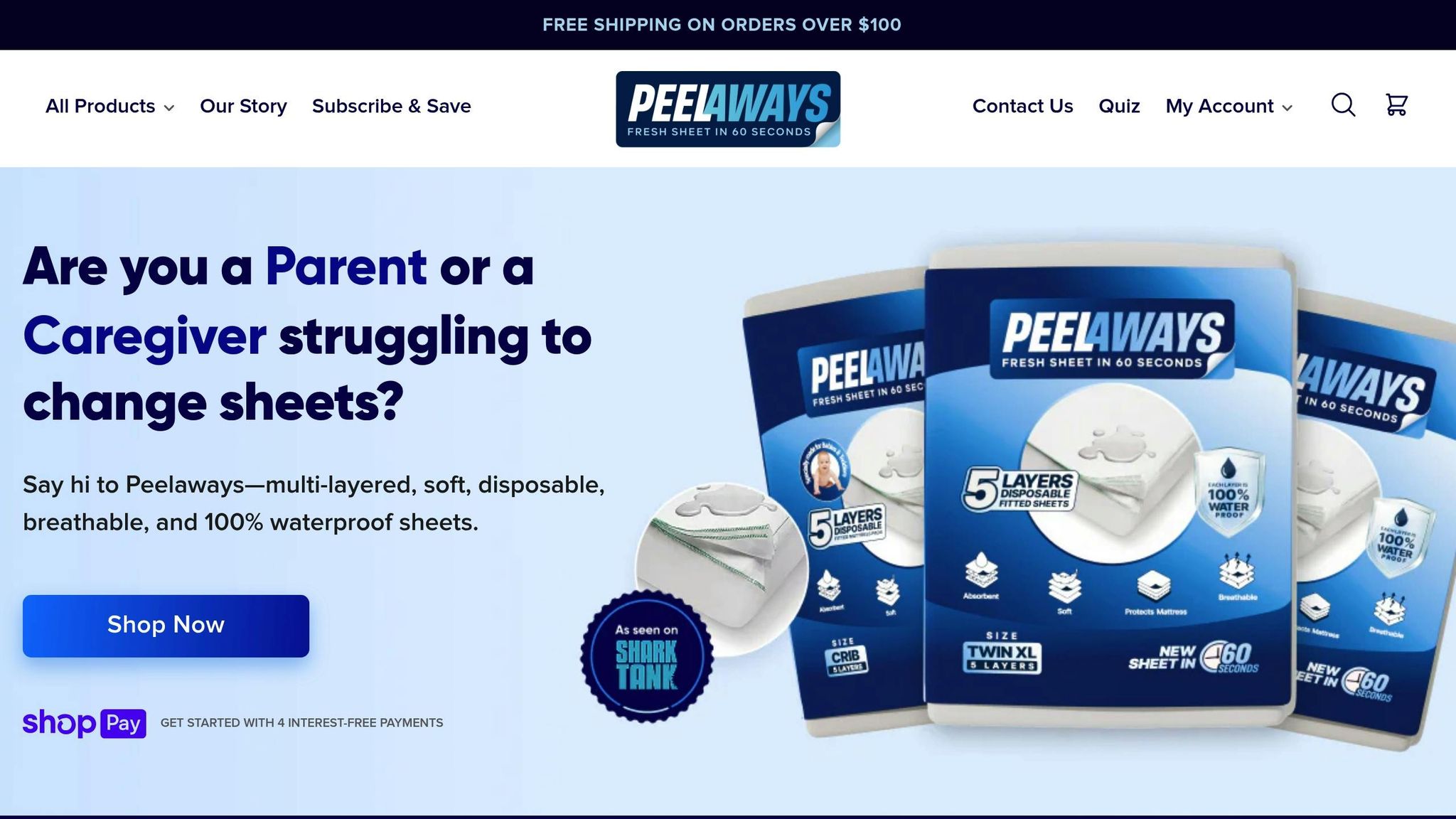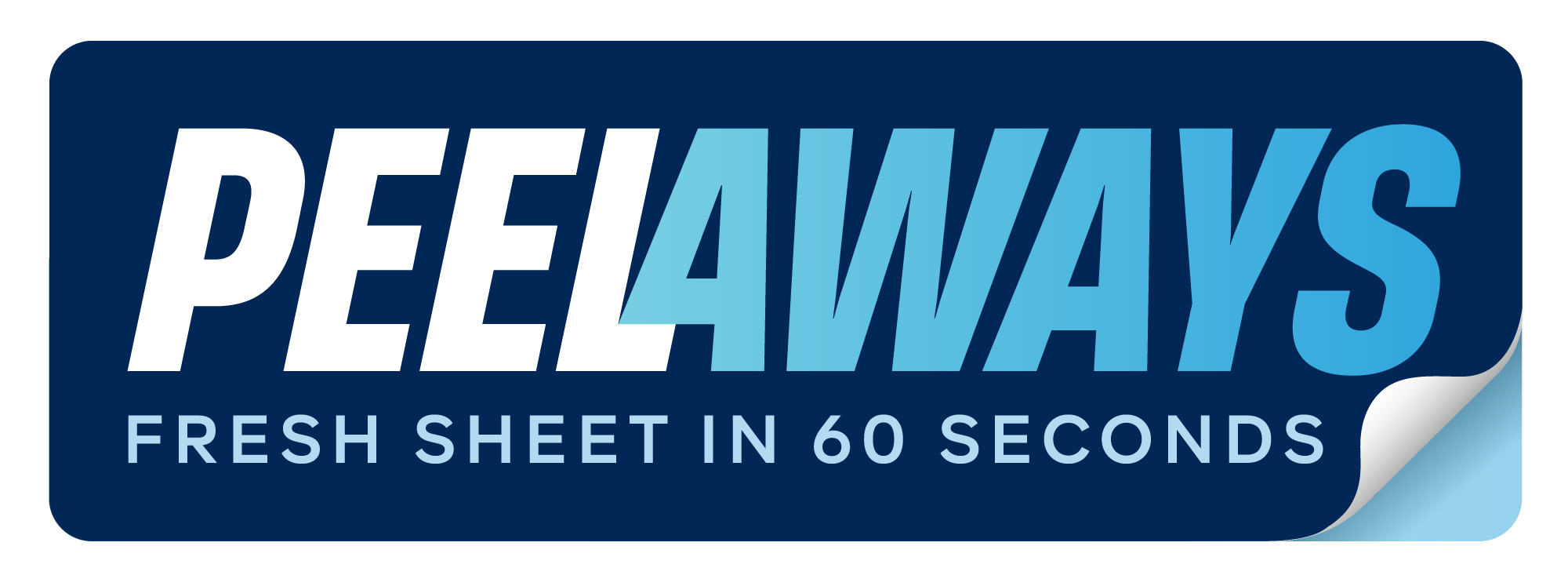Travel Beds vs. Disposable Sheets for Autism

When it comes to traveling with individuals on the autism spectrum, two popular bedding solutions stand out: travel beds and disposable sheets. Each addresses specific challenges like sensory sensitivities, safety, and hygiene. Here's a quick breakdown to help you decide:
- Travel Beds: Provide a secure, enclosed sleep space to reduce wandering and sensory disruptions. They prioritize safety but come with high upfront costs ($2,000–$5,000) and require setup time. Ideal for families prioritizing safety and comfort.
- Disposable Sheets: Lightweight, waterproof, and easy to replace, these sheets simplify cleaning and maintain hygiene. Affordable upfront ($30.99–$53.99 per pack) but involve recurring costs. Perfect for managing incontinence and quick bedding changes during travel.
Quick Comparison:
| Factor | Travel Beds | Disposable Sheets (PeelAways) |
|---|---|---|
| Sensory Comfort | High – enclosed, calming | Moderate to High – soft layers |
| Portability | Moderate – bulky | Very High – compact, lightweight |
| Ease of Cleaning | Moderate – requires washing | Very High – peel and replace |
| Incontinence Handling | Limited – needs covers | Excellent – waterproof, multi-layer |
| Cost | $2,000–$5,000 upfront | $30.99–$53.99 per pack |
| Safety for Wandering | Excellent – enclosed design | Not applicable |
What’s Best for You?
If safety and sensory comfort are your priorities, a travel bed may be worth the investment. For families managing incontinence or seeking convenience, disposable sheets like PeelAways offer a practical solution. Combining both can balance safety and hygiene effectively.
Travel Beds: Features, Benefits, and Drawbacks
What Are Travel Beds?
Traveling can be especially challenging for individuals with autism, and travel beds offer a portable solution that combines comfort and safety. These beds are designed to be easily transported and quickly set up, with most models available in two main types: inflatable or foldable. Both options are made to collapse compactly for convenient transport and storage[4][5].
For families managing autism-related needs, specialized travel beds like The Safety Sleeper® stand out for their advanced features. These beds are packed in durable, wheeled suitcases and include built-in electric pumps for quick and hassle-free setup. This makes it possible for parents to create a secure and calming sleep environment in just a few minutes, whether staying in a hotel or visiting family.
Benefits of Travel Beds for Autism
Travel beds offer a range of advantages for families navigating autism-related sleep concerns.
Enhanced Safety Features
Many travel beds are designed with high side rails, enclosed spaces, and locking mechanisms to prevent nighttime wandering, falls, or self-injury. Their sturdy construction is built to handle repetitive behaviors such as bouncing, rocking, or pulling at fabrics[2][5][6].
Sensory-Friendly Design
These beds often include features like soft, smooth textures, noise-dampening materials, and adjustable lighting, all aimed at creating a calming environment. The enclosed designs can help reduce sensory disruptions, promoting better sleep for individuals with heightened sensitivities[2][5].
Medical Access
Some models are equipped with medical access points, making it easier for families to accommodate tubing, lifts, or other medical devices. This is particularly helpful for children with complex medical needs, providing peace of mind for caregivers when traveling[5].
While these advantages are compelling, it’s also important to consider the practical challenges that come with using travel beds.
Drawbacks and Limits of Travel Beds
Despite their benefits, travel beds do present some challenges that families should weigh carefully.
Cost
The Safety Sleeper®, one of the top travel beds for autism, can cost between $3,000 and $5,000 depending on the features and customizations selected[5]. While some insurance plans or Medicaid waivers may help cover the cost, the initial expense can be a significant barrier for many families.
Bulk and Setup
Even though these beds are designed for portability, they can still take up a lot of space, even when packed in their wheeled cases. Setting up the bed at each destination requires time and effort, which may reduce overall convenience[4][5].
Maintenance Needs
Travel beds require regular cleaning and upkeep, and issues like air leaks or fabric damage can arise, especially during frequent use. Limited support for repairs while on the road can add to the challenges[4][5].
Incontinence Solutions
Most travel beds do not come with built-in solutions for managing incontinence or bedwetting. Families often need to rely on additional items, such as waterproof mattress covers or disposable sheets, which can add to the complexity of using these beds[5].
Durability Over Time
Although these beds are built to handle repetitive behaviors, the specialized materials and construction may require extra care over time. Frequent travel can increase wear and tear, making durability a concern for long-term use.
Being aware of these limitations is crucial when deciding whether a travel bed is the right choice or if alternative solutions, like disposable sheets, might be more practical.
Disposable Sheets: Features, Benefits, and Drawbacks
What Are Disposable Sheets?
Disposable sheets are specially designed products made with multiple layers that are absorbent and waterproof. They serve as a protective barrier for mattresses, shielding them from spills, accidents, and contaminants. What makes these sheets stand out is their ease of use - once soiled, they can be quickly removed and replaced, eliminating the need for laundry. They also create a clean and fresh sleeping surface, which can help reduce bacteria, allergens, and odors. This is particularly beneficial for individuals with autism, as it minimizes sensory triggers like unpleasant smells or textures.
Benefits of Disposable Sheets for Autism
Quick and Easy Cleanup
When accidents happen, disposable sheets can be replaced in no time, helping to maintain consistent routines. For individuals with autism, predictable routines are often key to reducing anxiety, and a smooth bedtime or morning transition can make a big difference for both them and their caregivers.
Minimizing Sensory Triggers
Removing wet or odorous bedding quickly can help avoid distress caused by unpleasant sensations. According to Autism Speaks (2023), incontinence and bedwetting affect 20–40% of children with autism, making disposable sheets a practical solution for reducing sensory discomfort linked to wetness or smells.
Great for Travel
Lightweight and compact, disposable sheets are perfect for travel or overnight stays. Whether you're staying in a hotel, visiting relatives, or even spending time in a hospital, these sheets ensure a clean and familiar sleeping environment wherever you go.
Eases Caregiver Responsibilities
For caregivers, the simplicity of disposable sheets means no heavy lifting or endless laundry. This ease of use not only saves time but also reduces the physical and emotional strain that often comes with managing accidents, allowing caregivers to focus on other priorities.
One standout option in this category is PeelAways, which showcases these advantages effectively.
PeelAways: A Multi-Layer Disposable Sheet Solution

PeelAways has a patented design that includes 5 to 7 soft, absorbent layers, depending on the size. When the top layer becomes soiled, it can be peeled away to reveal a fresh sheet underneath. This eliminates the need for washing or lifting mattresses, making it a hassle-free option.
Thoughtful Design Features
PeelAways sheets are fully waterproof but still breathable, thanks to a special membrane that blocks liquids while allowing airflow. This keeps the bed cool and dry throughout the night. They’re also noiseless and maintain the natural feel of the mattress, which is a plus for those with sensory sensitivities. Importantly, they’re free from harsh chemicals like Vinyl, PVC, Phthalates, and fire retardants, making them safe for sensitive skin.
Available Sizes and Pricing
PeelAways come in a range of U.S. bed sizes, with prices varying based on size and layer count:
- Crib-A-Peel (5 layers): $30.99 - ideal for toddlers.
- Cot and Twin XL (7 layers): $34.99–$41.99 - great for travel and special needs.
- Standard sizes (Twin, Full, Queen, King): $34.99–$53.99.
What People Are Saying
PeelAways has received over 6,000 five-star reviews, with an average rating of 4.8. One satisfied customer, Jalene Stanger, shared:
"These have relieved a lot of stress. They hold a LOT of liquid and are easy to use and tear away. No more 15 loads of laundry and wet mattresses!"
Drawbacks and Limits of Disposable Sheets
Recurring Costs
Since these sheets are single-use, they need to be regularly purchased. While they can save money on laundry and mattress replacements, the ongoing expense can add up over time compared to reusable bedding.
Environmental Concerns
Being disposable, these sheets contribute to landfill waste. While some brands are working on biodegradable or compostable options, the environmental impact of single-use products remains a concern.
Sensory Preferences
Even though most disposable sheets are made from soft, hypoallergenic materials, sensory preferences vary. Some individuals with autism might still find the texture or sound of these sheets uncomfortable. It’s worth trying different brands to find the best fit.
Limited Customization Options
Unlike traditional bedding, disposable sheets don’t offer much variety in terms of texture, weight, or material. For those who require a highly specific sensory experience, this lack of customization might be a drawback.
Which Safety Bed Is Best For Travel?
sbb-itb-45288fe
Travel Beds vs. Disposable Sheets: Side-by-Side Comparison
When choosing the right bedding solution for autism, it’s all about identifying what fits your unique needs. Whether it’s for travel or managing incontinence, here’s a detailed comparison to help you decide.
Comparison Table
| Factor | Travel Beds | Disposable Sheets (PeelAways) |
|---|---|---|
| Sensory Comfort | High – enclosed, calming setup with soft padding | Moderate to High – soft, noiseless materials that maintain mattress feel |
| Portability | Moderate – bulkier; some models like The Safety Sleeper® have wheeled cases | Very High – lightweight, compact, and shippable to your destination |
| Ease of Cleaning | Moderate – requires washing bedding and sometimes the bed itself | Very High – peel off soiled layers in under a minute, no laundry needed |
| Incontinence Management | Limited – needs waterproof covers and bedding changes | Excellent – multi-layer waterproof protection for large liquid amounts |
| Upfront Cost | $2,000–$5,000 | $30.99–$53.99 per pack |
| Long-term Cost | One-time investment, durable over years | Ongoing – about $1–$5 per layer used |
| Size Availability | Limited by brand; some customization options | Available in all major U.S. sizes: Crib, Cot/Twin XL, Full/Queen/King |
| Safety for Wandering | Excellent – enclosed design prevents falls and wandering | Not applicable – no containment features |
| Setup Time | Moderate – requires assembly, even for portable models | Instant – just place on the mattress |
| Independence | May limit independence due to enclosed nature | Promotes independence – easy for individuals to change themselves |
This breakdown highlights key differences to consider when choosing between the two.
Travel beds shine in providing security and sensory comfort, especially for children prone to wandering. The enclosed design offers peace of mind for parents and a calming environment for kids. On the other hand, disposable sheets are all about convenience and hygiene. For families managing incontinence - affecting 20–40% of children with autism [3] - the ability to change bedding in seconds without lifting heavy mattresses or dealing with laundry is a game-changer.
Cost is another factor to weigh. Travel beds come with a high upfront price but are built to last for years. Disposable sheets, though cheaper initially, come with ongoing expenses. For families traveling often or dealing with daily incontinence, the ease of disposable sheets can outweigh their recurring costs.
Portability also sets the two apart. While travel beds are portable, they’re bulky and require assembly, taking up valuable luggage space. Disposable sheets, on the other hand, are compact, lightweight, and can even be shipped directly to your destination, making them a hassle-free option.
Many families discover that combining both solutions works best. A travel bed provides security and sensory comfort, while disposable sheets handle cleanup and hygiene effortlessly. Together, they create a practical, balanced approach to addressing both safety and the everyday challenges of autism-related sleep and incontinence needs.
How to Choose the Right Solution for Your Needs
Finding the right bedding solution for autism involves carefully considering three main factors: sensory needs, incontinence management, and travel habits. It’s all about striking a balance between comfort and safety while addressing specific requirements.
Start by focusing on sensory sensitivities. Sleep disturbances are common among children with autism due to heightened sensitivity to textures, sounds, and changes in their environment. For this reason, travel beds with enclosed designs can create a calming, predictable space. These beds minimize exposure to unfamiliar stimuli with their smooth surfaces and minimal gaps, offering a sense of security.
For those who prefer the familiar feel of their own mattress, disposable sheets like PeelAways are a helpful option. These sheets protect the mattress while maintaining its natural texture and comfort. PeelAways are designed with multiple soft, absorbent layers and a peel-and-dispose system, making bedding changes quick and hassle-free. With over 6,000 five-star reviews and an average rating of 4.8 [1], they’ve been highly praised for providing a comfortable sleep experience without altering the mattress’s original feel.
Disposable sheets also ease the workload for caregivers, allowing bedding changes in under a minute - an especially practical feature for managing incontinence during travel. Speaking of travel, how often your family is on the move should also influence your choice.
Families who frequently travel - whether for vacations, medical appointments, or family visits - need solutions that are portable and easy to set up. Travel beds are a good option for security and comfort but can require more space and setup time. Disposable sheets, on the other hand, are lightweight, compact, and can even be shipped directly to your destination, making them a convenient choice for hygiene on the go.
For families dealing with wandering behaviors, travel beds provide added security, while disposable sheets simplify hygiene and upkeep, especially when frequent bedding changes are necessary.
Cost is another important consideration. Travel beds are a long-term investment, with prices ranging from $1,500 to $5,000. While expensive, they’re built to last and may be partially covered by insurance or Medicaid waivers. In contrast, disposable sheets like PeelAways cost between $30.99 and $53.99 per pack. Though they involve ongoing expenses, they offer immediate convenience and reliable hygiene benefits.
For many families, combining a travel bed for safety with disposable sheets for hygiene strikes a practical balance. To ensure you’re making the right choice, consult specialists, test options at home, and take advantage of trial periods to assess comfort and effectiveness.
Finally, keep chemical sensitivities in mind. PeelAways are free from vinyl, PVC, phthalates, and fire retardants, providing a breathable and odorless surface for better sleep.
Ultimately, the best bedding solution comes down to balancing safety, comfort, convenience, and cost to suit your family’s unique needs. As circumstances change, staying flexible and open to adjustments will help you find the most effective long-term solution.
Conclusion: Key Points to Remember
When deciding between travel beds and disposable sheets for autism-related needs, each option caters to specific challenges and priorities.
Travel beds are ideal for ensuring safety and comfort, especially for children who may wander or need a secure, familiar sleeping environment. Since sleep issues impact up to 80% of children with autism [7], having a controlled and calming sleep space can make a big difference during travel. However, these beds come with a hefty price tag - typically ranging from $2,000 to $5,000 - and require extra time for setup and storage, which might not suit every family’s needs.
On the other hand, disposable sheets offer convenience, hygiene, and simplicity. They eliminate the need for laundry, reduce the risk of cross-contamination, and make bedding changes quick and hassle-free - perfect for situations where washing facilities are unavailable. A standout option is PeelAways, featuring a multi-layer design with 5 to 7 layers per sheet. With over 6,000 five-star reviews and an average rating of 4.8 stars, they’ve become a trusted choice for families dealing with incontinence and sensory sensitivities. Priced between $30.99 and $53.99 per pack, they’re also a budget-friendly solution for ongoing use.
PeelAways combine a soft, breathable texture with waterproof protection, allowing bedding changes to be completed in under a minute - no mattress lifting required. This quick process helps reduce disruptions, particularly for children who are sensitive to changes in their surroundings.
FAQs
What should I consider when choosing between a travel bed and disposable sheets for a child with autism?
When choosing between a travel bed and disposable sheets for a child with autism, it’s important to weigh factors like portability, ease of cleanup, and comfort. Disposable sheets, especially those with a multi-layer peel-away design, can be a lifesaver for handling spills or accidents. Instead of dealing with laundry or lifting the mattress, you simply peel away the top layer, making them a convenient option for families on the move or during hectic moments.
These sheets come in a range of sizes - from crib to king - and are crafted to be soft, waterproof, and straightforward to use. Whether you’re at home or traveling, they help create a clean and hassle-free sleeping space, making life just a little bit easier.
What are the benefits of using travel beds and disposable sheets for children with autism, especially regarding sensory needs and safety?
Travel beds and disposable sheets can make a big difference for children with autism, especially when it comes to managing sensory sensitivities and ensuring safety. Travel beds offer a portable and familiar sleeping space, which can ease anxiety and improve sleep while away from home. Plus, their compact, enclosed design creates a secure area, helping to prevent falls or wandering during the night.
Disposable sheets, such as those from Peelaways, add another layer of convenience and comfort. These multi-layered, waterproof sheets let caregivers peel away a soiled layer to instantly reveal a clean one underneath - no washing or heavy lifting required. This simple solution keeps the sleeping area fresh and reduces interruptions, which can be particularly helpful for children sensitive to changes in their environment. Combined, these tools can make traveling smoother and more enjoyable for both kids and their families.
Are there programs or resources that help cover the cost of travel beds for children with autism?
Currently, there isn’t detailed information specifically about financial assistance programs for buying travel beds for children with autism. However, families might find it helpful to look into general resources such as local autism support groups, non-profit organizations, or government programs that provide funding or grants for special needs equipment.
For tailored advice, reaching out to a social worker, case manager, or a local advocacy group focused on autism support could be beneficial. These professionals and organizations can help pinpoint funding options or community resources available in your area.
Related Blog Posts
- Disposable vs. Washable Bed Sheets: Comparison
- Peelaways vs. Traditional Waterproof Sheets
- Waterproof Mattress Pads vs. Disposable Sheets
- Solutions for Nighttime Accidents in Autism Care
Comments
0

SAVE MONEY & WATER
Professionals & Institutions save a fortune on labor/laundry.

SUPERIOR COMFORT
The first thing our customers notice is how soft our sheets are.

100% WATERPROOF
Each layer is 100% Waterproof, perfect for spills and accidents

SAVE TIME
Change the sheet in under 1 minute without stripping the bed.




Leave a comment